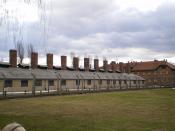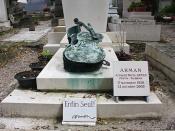The global trauma of World War II, particularly the events that took place at Auschwitz and Hiroshima, caused dramatic changes in the visual arts. New ideas and criticisms of culture and society had come about, and artists were responding--consciously and unconsciously--to the war.
New ideas about the arts had emerged shortly after the war. The long-standing notion that the arts make society more civilized and raise people above their instincts of fear and violence was proven untrue. Consequently, art's very right to exist came into question. In 1949, Theodor Adorno stated in his essay, "Cultural Criticism and Society", that "to go on writing poetry after Auschwitz is barbaric". He argued that new rules and conventions for art must be found and the old ones must be abandoned.
One major attempt in creating these new rules and conventions is when art's main concern shifted from object-making to performativity. Jackson Pollock was among the first to make this transition.
With his all-over drip paintings of the late 1940's, he had successfully liberated painting into becoming a kind of performance. His process has been described as a kind of dance with the canvas and paint. When examined closely, the viewer can trace the first marks made to the very last ones. In response to the controversy surrounding his method of painting, Pollock stated that "New needs need new techniques...the modern painter cannot express this age, the airplane, the atom bomb, the radio, in the old forms of the Renaissance or of any other past culture." His mention of the atom bomb proves that Pollock's method was a kind of response to the trauma of WWII.
An artist as equally performative as Pollock was Lucio Fontana. In works such as Concetto Spaziale, Fontana attacks the surface of the canvas, thereby focusing the...


